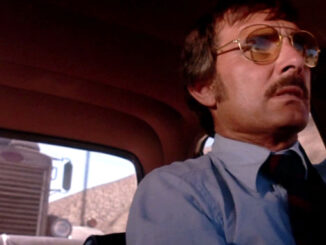
by Kevin Lewis
Woody Guthrie left a depressed California 70 years ago this March to find work in New York as a folk singer. He had been a popular radio personality in Los Angeles, so he attended the opening screenings of The Grapes of Wrath in hopes of making contacts. Instead, he was so inspired by the plight of the desperate Joad family, who fled the dust bowl and joined the wagon train of failing jalopies on Route 66 to California to pick oranges, that he wrote “Tom Joad” in homage to Henry Fonda in the role. John Steinbeck, the author of the Pulitzer Prize-winning novel that became the iconic movie, wrote that Guthrie achieved in 17 stanzas what it took him over 600 pages to write. The John Ford film proved just as inspirational, and true to the “This Land Is Your Land” philosophy of Guthrie. It is still considered one of the great works of art in international cinema.
The Ford movie has always been a meeting place between left and right film critics and academics. The Indian-fighting Westerns of Ford have divided critics because they espouse duty, honor and country at the expense of the exploited. In The Grapes of Wrath, Ford criticized a capitalistic society that callously abandoned its rural citizens when their foreclosed lands were confiscated by the banks. The Steinbeck novel is much harsher, racier and earthy than the movie version, which was produced and written by Darryl F. Zanuck’s favorite screenwriter, Nunnally Johnson, and released by 20th Century-Fox. Zanuck always had a liberal philosophy and, in fact, was the only producer in Hollywood who would have tackled the depressing saga and championed the American spirit that would overcome despair. Warner Bros. would have been the other logical producing studio, but it was then focusing on urban crime rather than rural tragedy. Ford was chosen to direct over the other choices, Henry King and Clarence Brown.
Ford was likely attracted by the material because he realized that the Joads and their ilk were probably the descendants of the original Indian fighters who settled Oklahoma, whom he would celebrate in future films. Seen in this light, The Grapes of Wrath is a sequel to the Ford Westerns (the majority of which were made after this film in the 1940s and 1950s). The Okies settled in California, concentrating in the Bakersfield, Los Angeles and Orange County areas, and became the disciples of Ronald Reagan when they became prosperous. If Warner had produced the film, its contract star Reagan (when he was still a New Deal advocate) may have played Tom Joad.
Fonda became an iconic figure with this film, as the ex-con, labor-organizing Tom Joad. He had made a critical impact playing Abraham Lincoln in Young Mr. Lincoln (1939) and the farmer-turned-revolutionary in Drums Along the Mohawk (1939), both directed by Ford, and the actor and director worked together many times after that. Many feel he should have won the Oscar as Best Actor for Grapes (which instead went to James Stewart for The Philadelphia Story) but Fonda, who came from the Broadway stage, in many ways was always a Hollywood outsider despite his long film career.
Zanuck thought that Ford had the greatest sense of film composition he had ever encountered.
Jane Darwell as Ma Joad won the Best Supporting Actress Oscar, and she is unforgettable in the role. Although, she is too stout for Steinbeck’s rail-thin matriarch, which would have been perfectly realized by Beulah Bondi, the original choice for the role. Bondi was bitter at losing the part, particularly since she did the research on these displaced people with Ford.
This was also probably the most distinguished dramatic film of Robert Simpson’s film editing career at Fox. He specialized in editing lighter fare for Fox, including Miracle on 34th Street (1947), the Betty Grable musicals, and the prestige musicals such as The King and I (1956) and South Pacific (1958). Ford was a director known for resisting the intrusive editorial hand of producers, like Zanuck, by editing in the camera, framing compositions and scenes without alternate choices.
The cinematography by Gregg Toland replicated beautifully the signature Depression photography of Dorothea Lange and Arthur Rothstein. Toland, most famous for his deep-focus cinematography for the films of William Wyler and Orson Welles, created landscapes that almost become three-dimensional in their power to suggest barren, dusty land and heartbreaking roadside camps. Zanuck thought that Ford had the greatest sense of film composition he had ever encountered. Indeed, the Ford/Toland team created a unique, seamless documentary look for this major studio film.
The Grapes of Wrath, which won Ford his second of four directing Oscars––but lost Best Picture to Rebecca (1940)––was a daring choice for 1940. President Franklin Delano Roosevelt was a popular figure campaigning for a third term, but he had never really resolved the Depression. America was still living on dreams and hope. The country would soon enter into World War II, which would resolve some of the unemployment. But long-term Southern politicians fought many of the New Deal programs (which were not unlike the economic stimulus programs of the present day), and regarded Steinbeck and his book as Communist-inspired. To produce a film about the failure of capitalism, in order to save vast numbers of devalued citizens, took courage on Zanuck’s part when the Dies Committee on House Un-American Activities was already investigating Communist influence and had closed down the Federal Theatre program.
The Ford movie has always been a meeting place between left and right film critics and academics.
Zanuck ended the film on a hopeful, mystical note, very different from the complete destruction of the family unit in the book. Tom Joad is forced into hiding for his labor activities and the family continues on their journey to the Promised Land of California without him. He tells a grieving Ma Joad that he is only one piece of a big soul that belongs to everybody. “Wherever there’s a fight so hungry people can eat, I‘ll be there,” he says. “Wherever there’s a cop beatin’ up a guy, I‘ll be there… And when our people eat the stuff they raise, an’ live in the houses they build, why, I’ll be there too.”
Ma Joad had the final say when she states that she, the family and their roadside pilgrims are really the people––not the city dwellers who wither from unfulfilled consumerism. “We‘re the people that live,” she says. “Can’t nobody wipe us out. Can’t nobody lick us. We’ll go on forever. We’re the people.” And those people did endure, working in munitions plants, finding work in the studios and fighting in World War II. And when they became sick on their industrial-polluted lands, they were saved by another descendant of the Joads, Erin Brockovich.
The film even inspired Fonda’s daughter Jane. When Henry died in 1982, soon after finally winning a Best Acting Oscar for On Golden Pond (1981), Jane sent a beautiful card to thank those who wrote to her, remembering her father. On the front was a head shot of Henry as Tom Joad, and on the inside was his speech about labor organizing and keeping the American Dream alive. (I have one of those cards, sent to me by Jane after I wrote a eulogy article about her father.)





